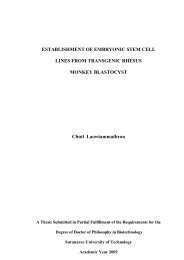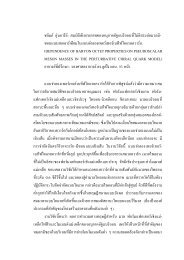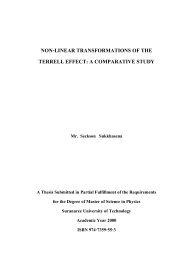PRODUCTION Of NUTRIENT SOURCES FOR RHIZOBIUM
PRODUCTION Of NUTRIENT SOURCES FOR RHIZOBIUM
PRODUCTION Of NUTRIENT SOURCES FOR RHIZOBIUM
You also want an ePaper? Increase the reach of your titles
YUMPU automatically turns print PDFs into web optimized ePapers that Google loves.
Table 4. (continued).<br />
Characteristic Characteristic<br />
Order Order<br />
Family Family<br />
Genus Genus<br />
Platygloeales<br />
Sirotrema<br />
Cystobasidiaceae<br />
Tremella<br />
Colacogloea Trimorphomyces<br />
Cystobasidium B. Basidia aseptate<br />
Kriegeria b Filobasidiales<br />
Mycogloea Filobasidiaceae<br />
Occultifer Cystofilobasidiumf Septobasidium Syzygospora<br />
Atractiellalesd Anamorphic taxa<br />
Chionosphaeraceae Sporobolomycetaceae<br />
Chionosphaera Bensingtonia pro parte<br />
Stilbum Kurtzmanomyces<br />
Agaricostillbales Rhodotorula pro parte<br />
Atractogloeaceae Sporobolomyces pro parte<br />
Agaricostilbum Sterigmatomyces<br />
B. Basidia globose, nonseptate Cryptococcaeae<br />
Graphiolales Bullera<br />
Graphiolaceae Cryptococcus<br />
Graphiola Fellomyces<br />
C. Basidia cylindric, nonseptate Kockovaella<br />
Cryptobasidiales Phaffia<br />
Cryptobasidiaceae Trichosporon<br />
Conyodyctum Tsuchiyaea<br />
Cryptobasidium Udeniomyces<br />
?Hyalodendron<br />
?Moniliella<br />
a Although economically important smuts have studied in detial, type of teliospore germination is unknown in many species.<br />
Direct conjugation of basidial cells occurs in some taxa with Ustilago-like basidia and this can result in the complete absence<br />
or infrequent occurrence of a yeast state.<br />
b Kriegeria (Xenogloea) eriophori (monotypic) parasitizes monocots; its relationship to the mycoparasitic taxa placed in the<br />
Cystobasidiacese and to most other Platygloeales, may by distant.<br />
c Yeast states probably occur in these two genera.<br />
d Basidia can be cylindric, transversely septate (e.g. in Stilbum), or clavete holobasidia (e.g. as in Chionosphaera).<br />
e Itersonilia perplexans appears to belong in this group (but see also under f), but basidia have not been found. Because of the<br />
known features and the rather isolated position among anamorphic yeast groups, it is classified with the Tremellales here.<br />
��






